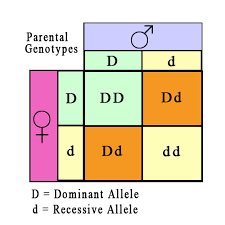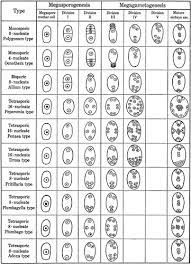TYPES OF HYBRID CROSSES - Pedigree, Bulk, Back, Single, Double, Multiple cross methods
TYPES OF HYBRID CROSSES
Methods to perform intraspecific hybridization :
Pedigree method
Bulk method
Back cross method
Single cross method
Double cross method
Multiple cross method
Pedigree Method:
The word pedigree refers to a line of ancestors. Selection
of a improved variety from a line of ancestors established from El individuals,
is known as pedigree method. It is widely used by plant breeders to improve
self-pollinated crops. It is a quick method of crop improvement that enables
the plant breeder to re lease new varieties in 9-10 years. Pedigree method is
best suited t improve visible phenotypic characters in plants. Here, progenies
superior plants only selected to proceed the next generation.
The pedigree method of breeding involves the following main
steps:
1. In the first year,
the parent plants having characters to steps: brought together in the new
variety are selected and crossed manally. Seeds are collected from the crossed
plants. 2. In the second year, the hybrid seeds thus obtained are so in a small
plot to raise 50-200 F1 plants. After raising the FI generation, individual
plants are selected based on desired characts seen in them. One or two plants
are selected for each desired tnt Thus 50-100 plants are selected from F1
plants and the seeds a collected separately. The seeds are often called second
seed generation (SG 2). Unwanted plants are discarded.
3. In the third year, seeds collected from each and every 1
plant are sown in a linear row in the field to raise F2 generation. C or two
standard varieties are also grown in separate rows for ca parison. A great
genetic variability appears in the F2 individuals.. as the number of
individuals increases, there is a chance to get desired gene combination.
Pathogens and pests may be artificially -introduced to test disease and pest
resistance of the F2 plants. Plats with desired characters are selected and
seeds are collected seperately. The seeds are called third generation seeds (SG
3). Jis eased plants and other inferior plants are discarded. The details of
the number of line, the desired character in the plant, disease appearance,
pest attack and others are noted in the field book.
4. In the fourth year, seeds collected from F2 generation
are sown in separate rows for raising F3 generation. Best rows are se lected
and then five plants are selected from each of the selected rows. Seeds are
collected from the plants of each row to raise the next generation crop.
Details of date of sowing, date of heading, disease appearance, insect and
weather damages, height of plants, number of tillers, strength of straw, date
of maturity and grain qualities are noted in the field book.
5. In the fifth year, F4 generation crop is raised from
seeds collected from F3 generation. The F4 population is handled in the same
way as done in F3 generation crop. But here only 50-100 plants are selected for
seed collection.
6. In the sixth year, F5 generation crop is raised from
seeds collected from F4 generation individuals. 25-50 best performing individuals
are selected and their seeds are collected to raise the next year crop. All the
unwanted individuals are discarded.
7. In the seventh year, F6 generation crop is raised from
seeds of F5 generation. At F6, most of the lines become homozygous and more or
less uniform due to successive self pollination. Plants showing such uniform
characters are selected and their seeds are collected and bulked together as a
new variety. Thus seeds of many varieties are prepared separately.
8. In the eighth and ninth years, field trials are conducted
with the varieties at a regional research station. The best performing one is
selected to release as a new variety and all other varieties are discarded.
9. In the 10th year, the seeds of the new variety is bulked, named and distributed to farmers.
Bulk Method:
Breeding in which seeds of superior individuals are
collected. bulked and sown repeatedly until a new variety is formed, is called
bulk method. It is used to breed self-pollinated crops. During this experiment,
selection is started from the F2 generation onwards. In the F1 generation, all
individuals are heterozygous and identical so that selection is altogether
impossible. In the F2 generation, individuals show much genetic variability,
leading to difference in the characters of individuals. The degree of
heterozygosity de creases while proceeding from F2 to F10 where all individuals
are homozygous. So, bulking is done upto get uniform individuals having desired
characters. It is achieved nearly in F6 generation.
2. In the second year, the seeds are sown in the field to
raise the F1 population of individuals. Seeds are collected from the Fl
individuals.
3. In the third year, the seeds of F1 generation are sown in
the crop field to raise F2 generation. One or two standard varieties are sown
in a separate line for comparison of results. Nearly 1000 plants showing
desired characters are selected from the F2 generation and their mature heads
are harvested to collect seeds. The collected seeds are mixed together to have
composite seeds.
4. In the fourth year, the composite seeds are sown in the
field to raise F3 generation. The F3 population is handled in the same way as
done in F2 generation.
5. In the fifth year, F4 population is raised and handled in
the same way as has been done in F3 generation.
6. In the sixth year, F5 generation is raised and handled in
the same way as has been done in F4 generation. But, seeds of selected
individuals are collected and stored separately,
7. In the seventh year, seeds collected from every plant are
sown in a separate line in the field to raise F6 generation. Standard varieties
are grown by them for easy comparison. 100-200 row are selected and seeds are
collected from plants growing in the rows
8. In the 8th and 9th years, seeds collected from each and
every row are sown in separate blocks to conduct field trials. Seeds fromthe
desirable blocks are collected separately and stored.
9. In the 10h-12th years, seeds from the desirable blocks
are sown in separate blocks of a field in the regional research station and
crop is raised.
10. Seeds from best performing blocks are bulked, named and distributed as a new variety to farmers.
Backcross Method:
Hybridization method in which the FI hybrid is crossed with
one of its parents, is called backcross method. It was first used in plant
improvement by Harlan and Pope in 1922. This method is practised when one or
two characters have to be transferred to otherwise superior variety (ie. plant
with all desired characters but deficient in one or two likely features). It
has been employed in the improvement of both self-pollinated and
cross-pollinated crops deficient in one or two desired traits.
Backcross is a recurrent hybridization, ie. the cross is re
peated once again with a parent. The parent plant with one or two superior
characters is recurrent parent or recipient and the inferior parent, is called
donor parent. The Fl population is backcrossed with the recurrent parent to get
an improved variety. Characters encoded by single dominant or recessive genes
can be transferred to otherwise superior plants by backcrossing. Eg. Disease
resistance, drought resistance, earliness, etc. If a quantitative character is
to be transferred, backcross is repeated several times with the donor parent.
Backcross method of breeding can be explained with an example. In rice, C04 (Gobi Anaikomban) is blast resistant but the popular CO 13 (Arupathankodai) is sensitive to blast. The blast resistance is controlled by the dominant allele 'RR' and sensitivity to blast is determined by the recessive allele 'rr'. Blast resistance is transferred from CO 4 to CO 13 in the following way -
1. CO 4 is crossed with CO 13 to get a hybrid. This hybrid receives 50% genes from CO4 and 50% genes from CO 13.
2. The hybrid is backcrossed with CO 13 to produce improved hybrid.
The improved hybrid receives 75% CO 13 genes and 25% CO4 genes.
3. The improved hybrid is once again backcrossed with CO13.
The resulting hybrid receives 87.5% CO 13 genes and 12.5% CO 4 genes.
4. The hybrid thus obtained is once again crossed with CO 13
to produce still improved hybrid. This hybrid receives 96.875% CO 13 genes and
3.125 % CO 4 genes.
5. Because of successive backcrosses, the hybrid becomes
more and more like CO 13 variety, but 'R' gene is stabilized in it Therefore,
as a result of 6-8 backcrosses, blast resistant CO formed.
6. The blast resistant cultivars are selected using bulk
method and compared with parent CO 13. Then it is distributed to farmers
In wheat. Thatcher variety is resistant to rust, but they
grown Chinese spring variety is sensitive to rust. Therefore, rust resistance
is transferred from Thatcher to Chinese Spring by back cross method.
Striga resistance is transferred from Bonganhilo variety to
COI (Periamanjal Cholam) variety of sorghum at Tamilnadu Agr cultural College,
Coimbatore.
Pest and disease resistance of Saccharum spontaneum is transferred to S.officinarum, the cultivated noble cane.
Single Cross Method:
In this method. hybrids obtained from two or more single
crosses are crossed to get improved hybrids. This method was proposed by Shull
in 1909. It helps to get hybrid vigour in multiple allelic inheritance.
If four alleles A, B, C and D take part in the inheritance
of a character, four groups of plants which are pure-lines for those alleles
are selected and used in the breeding programme. The plants are grown in
separate rows and crossed in the following combinations: AXB, AXC, AXD, BXC,
BXD, CXD
The inbreeds produced from these crosses are analyzed for the degree of hybrid vigour. Those two inbreeds which show the maxi mum vigour are then crossed to improve the hybrid. The resulting hybrid is bulked and released as a new variety.
In this method, pure-lines for dihybrids are planted in alternative rows and crossed to get inbreeds. Then these inbreeds are planted in alternative rows and crossed. As a result, improved hybrids are formed. After proper selection and field trials, the improved hybrids are released to farmers.
This method is useful to transfer genes located in different chromosomes for getting improved hybrids. It brings together all desired traits in the hybrid plants. The wheat variety NP 809 was developed by using multiple cross method. Plants that are pure-lines for each of the desired traits are obtained by repeated crosses and selection. For example, in wheat there are three types of rust resistance so that three pure-lines are obtained by crosses followed by selection. Then every two pure lines are crossed to get the F, population. Thus two or more F populations are raised. If the pure-lines are A, B and C as in wheat, the crosses AXB and BXC are performed. Then F, individuals of AXB and BXC are crossed to get improved hybrid that is resistant to all the three types of rusts.









Comments